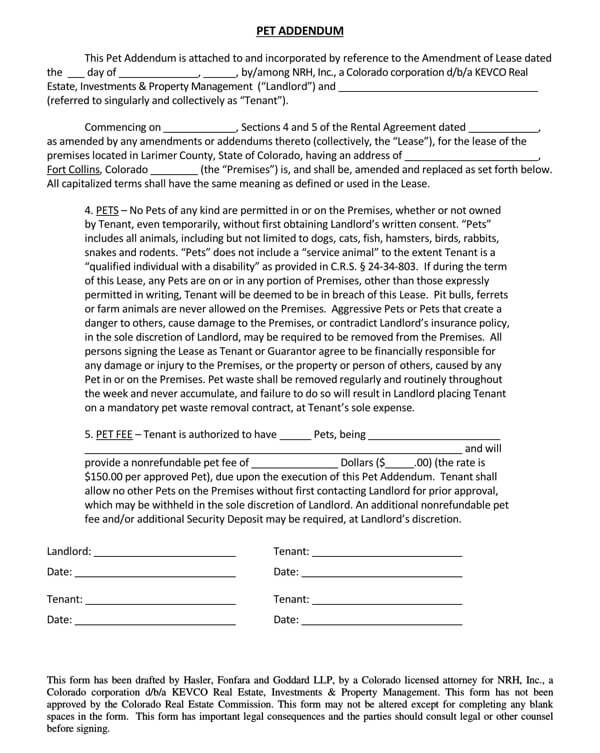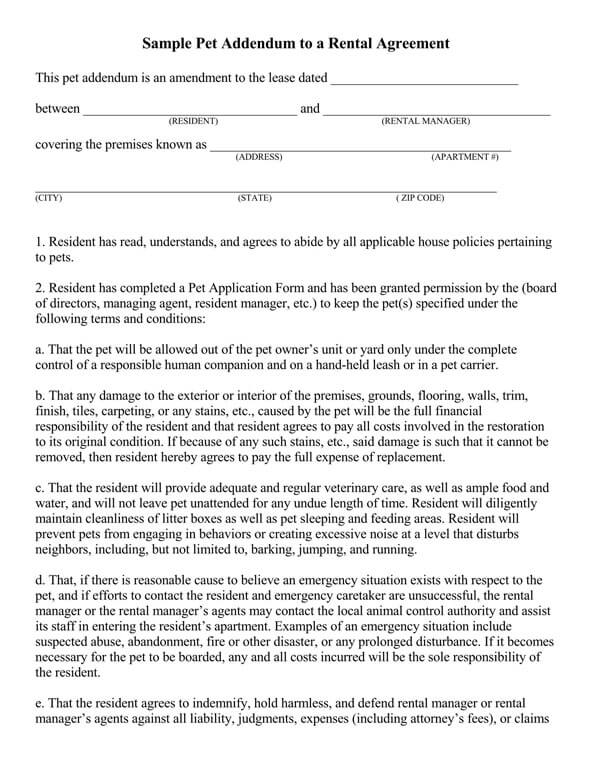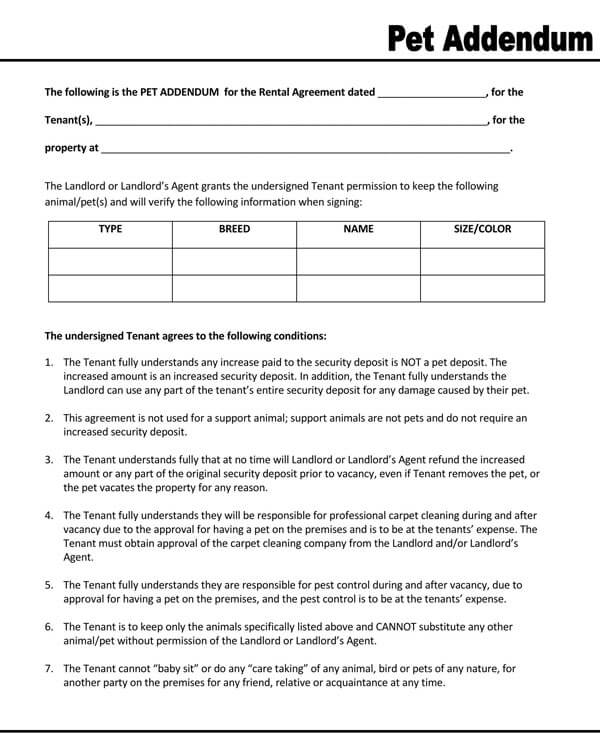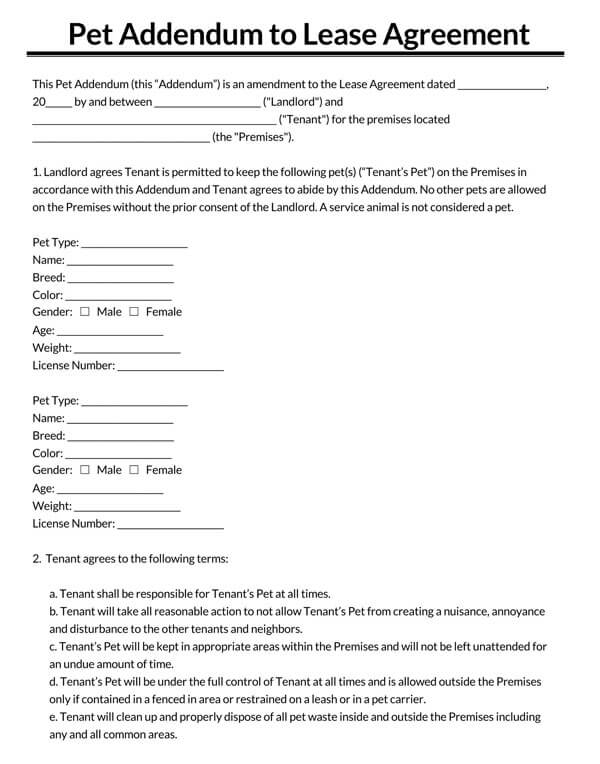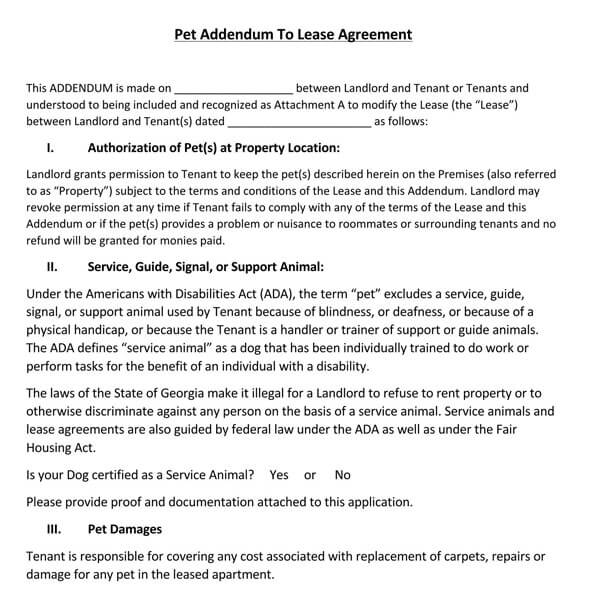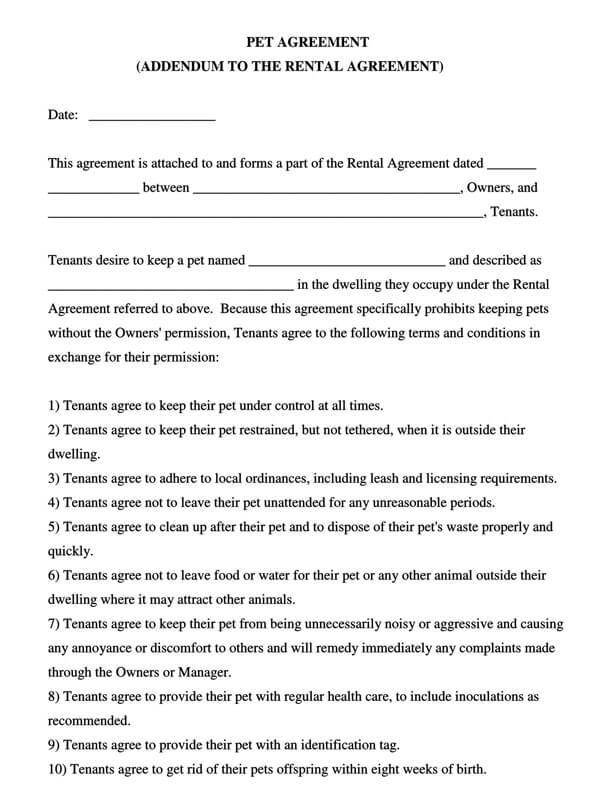Most landlords prefer having a no pet policy in their rental property because of the possible uncomfortable situation they may present to other tenants. In a situation where the pets become dangerous or destructive, the landlord and the tenant owning the pet have to face significant losses. It is, therefore, necessary for the landlord to protect himself by enforcing the Pet Addendum to Lease.
Free Templates
What is a Pet Addendum?
A Pet Addendum is a legally binding agreement between the tenant wishing to have a pet(s) on the rental premises and the landlord. A pet addendum to lease is considered to be added when the original lease agreement forbids tenants to have pets in the property or did not specify a provision based on tenants bringing pets into the leased premises.
The purpose of a pet addendum to lease is to update the original rental lease agreement between the landlord and the tenants, as now both the parties have changed their minds. The pet addendum to lease is presented by the landlord to permit a tenant to have pets and highlights the responsibilities, rights, and consequences of having pets on the property.
Alternate names of the pet addendum
A pet addendum is addressed with several other names as well. Typically these are;
- Pet Agreement for Rental
- Pet Addendum to Lease
- Pet Addendum Agreement
- Rental Unit Pet Policy
- Pet Rental Agreement
- Tenant Authorization Letter for a Pet
- Landlord Permission Letter for a Pet
- Landlord Letter of Consent for a Pet
- Consent for Pets with Conditions Letter
- Landlord Authorization Letter for a Pet
What are the Rights and Benefits of the Landlord?
The pet addendum gives the landlord legal rights to either apply a no pet policy or expect tenants with pets to comply with certain responsibilities, and be fully liable for the actions of their pets. These rights protect the interests of the landlord making it easy for him to retain tenants with pets. The rights of a property owner under the pet addendum include:
- The landlord has a right to demand tenants with pets to be mindful of their neighbours and ensure their pets do not disturb or cause any destruction.
- The landlord has a right to expect from tenants full responsibility for their pets’ actions at all times, hence protecting the landlord from lawsuits and damage expenses.
- The pet addendum mandates the landlord a right to demand that tenants keep the premises clean, by picking up the waste, dirt or litter etc left around by their pets either inside or outside their house.
- The landlord has a right to expect compensation from tenants whose pets cause damages to the property.
- The pet addendum gives the landlord a right to collect a security deposit amount from tenants with pets, to cater for any likely wear and tear caused by their pets during their stay in the premises.
- An insurance covering the landlord’s rights should be presented by the tenant in case their pet harms someone, the insurance would make compensations.
- The landlord has a right to not be sued for the damages or harms caused by the tenant’s pet, this means that pet owners are obligate to stand trial for their pet’s actions.
- The landlord also reserves the right to terminate the pet agreement and say no when the animal is destructive or if the agreement is violated by the tenant
- It is the landlord’s right that his tenant honours the terms of the original lease since the pet agreement does not replace the original rental agreement.
The landlord also benefits from permitting tenants with pets in their property under the pet addendum to lease. Some of these benefits the landlord stands to gain include:
- Landlords enjoy the profits of retaining tenants for longer periods since very few rental premises permit tenants to keep pets. A low tenant turnover rate means good business for landlords by eliminating the stress of always looking for new occupants to keep earning.
- Landlords are assured of leasing their premises to responsible tenants who are capable of taking care of their pet, which portrays such tenants may be responsible enough to pay their bills on time.
- The landlords get to earn more from tenants with pets, who are willing to pay extra for a conducive environment that is mindful and accommodative of their animals.
Quick Guide of Writing a Pet Addendum
Landlords should be keen on ensuring that the pet Addendum is a comprehensive document detailing all the terms and conditions and responsibilities of both parties involved. Essential elements that need to be covered in the Pet Addendum to Lease include the following:
- Date: Mention when the agreement was amended and when it was incorporated as part of the rental agreement. Dates are important in any contract showing the period when the tenant and the landlord were in agreement.
- Premises: State the premise the pet is permitted to stay including the house number of the tenant. The premises section is supposed to explain the extent to which the pet should move outside, and how far the pet can move around the premises under the supervision of their owners and must be on a leash.
- Personal information: The personal information of the Landlord including his full name and contact details should be provided in the pet Addendum. The Tenant’s personal information should also be fully detailed in the pet addendum providing their full name and contact information.
- Pet details: The tenant is supposed to provide specific descriptive details of the pet (s) they intend to have on the premises. There could likely be several tenants also having pets, hence each tenant should provide a precise description of their pets including their pet’s name, gender of the animal, breed, age, weight, colour and a legal number. This information including the legal number makes it possible for each tenant’s animal to be properly identified in case they are lost or cause damage. The type of animal allowed in the premises should be clearly detailed to avoid hosting dangerous animals.
- Pet fee: This may include a non-refundable fee charged for having a pet on the premises. Pet fees are compensation to the landlord to cater for any wear and tear expenses and damages caused by a tenant’s pet.
- Damage deposit: is a refundable amount in case the pet does not destroy anything during their stay on the premises.
- Pet rent: Pet rent is the regular extra rent fee charged for the pet. Tenants with pets are hence expected to agree to this extra charge before signing the contract.
- Signatures: The pet addendum should be sealed with signatures from both the landlord and the tenant
Consequences of Having Pets in the Premises without a Pet Addendum
Landlords are at the risk of facing damaging and financial consequences if they allow tenants to stay with pets on the premises without signing the Pet Addendum. Some of the consequences include:
- Landlords that do not enforce a pet addendum often experience a lot of time wastage, having to deal with disagreements that arise when the tenant’s pets become destructive, and they are not willing to compensate for the losses. The landlord will always be forced to pay for the damage in case the pets harm other tenants, which can be avoided by adding the pet addendum.
- The landlord will have to pay penalties to the Home Owner’s Association (HOA) when the tenants’ pets violate the neighbourhood restrictions. He or she will also have to hire cleaners to remove dirt and poop left around by tenant pets’ hosted in the premises without a pet addendum agreement.
- The landlord might also experience high turnover from tenants or neighbours who are annoyed by the pets that keep damaging their items. The landlord will have to spend a lot of effort in conflict resolution and in evicting tenants with damaging pets.
FAQs
What should be included in a pet addendum?
The pet addendum should state the parties involved including the full name of the tenant and the landlord. A descriptive detail of the animal’s appearance, color, breed, age, weight, and registration number or license should be stated. It should state where the pet is supposed to stay, and the date when the animal should begin living on the premises. It must mention reasons why the landlord is not liable for any damages or harm caused by the tenant’s pet
How do I add a pet addendum to my lease?
You can add the pet addendum to the original rental lease through an amendment making it part of the original legal contract between you and your tenant.
Is the pet addendum a legally binding document?
Yes, and the pet addendum forms part of the legally binding agreement or contract between the landlord and the tenant
Are landlords allowed to say no pets?
Yes, the decision as to whether to have pets on the premises belongs to the landlord who is the property owner. Hence, tenants must acquire permission from the landlords and if he/she says yes, they can go ahead to sign the pet addendum claiming full responsibility for the damages and harm caused by their pets.
